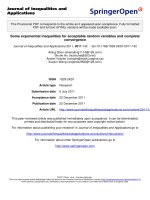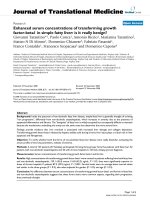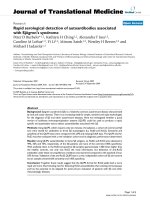Báo cáo hóa học: "Blood doping by cobalt. Should we measure cobalt in athletes?" docx
Bạn đang xem bản rút gọn của tài liệu. Xem và tải ngay bản đầy đủ của tài liệu tại đây (203.58 KB, 3 trang )
BioMed Central
Page 1 of 3
(page number not for citation purposes)
Journal of Occupational Medicine
and Toxicology
Open Access
Hypothesis
Blood doping by cobalt. Should we measure cobalt in athletes?
Giuseppe Lippi*
1
, Massimo Franchini
2
and Gian Cesare Guidi
1
Address:
1
Istituto di Chimica e Microscopia Clinica, Dipartimento di Scienze Morfologico-Biomediche, Università degli Studi di Verona, Verona,
Italy and
2
Servizio di Immunoematologia e Trasfusione, Azienda Ospedaliera di Verona, Verona, Italy
Email: Giuseppe Lippi* - ; Massimo Franchini - ; Gian Cesare Guidi -
* Corresponding author
Abstract
Background: Blood doping is commonplace in competitive athletes who seek to enhance their
aerobic performances through illicit techniques.
Presentation of the hypothesis: Cobalt, a naturally-occurring element with properties similar
to those of iron and nickel, induces a marked and stable polycythemic response through a more
efficient transcription of the erythropoietin gene.
Testing the hypothesis: Although little information is available so far on cobalt metabolism,
reference value ranges or supplementation in athletes, there is emerging evidence that cobalt is
used as a supplement and increased serum concentrations are occasionally observed in athletes.
Therefore, given the athlete's connatural inclination to experiment with innovative, unfair and
potentially unhealthy doping techniques, cobalt administration might soon become the most suited
complement or surrogate for erythropoiesis-stimulating substances. Nevertheless, cobalt
administration is not free from unsafe consequences, which involve toxic effects on heart, liver,
kidney, thyroid and cancer promotion.
Implications of the hypothesis: Cobalt is easily purchasable, inexpensive and not currently
comprehended within the World Anti-Doping Agency prohibited list. Moreover, available
techniques for measuring whole blood, serum, plasma or urinary cobalt involve analytic approaches
which are currently not practical for antidoping laboratories. Thus more research on cobalt
metabolism in athletes is compelling, along with implementation of effective strategies to unmask
this potentially deleterious doping practice
Background
Ergogenic drugs are substances commonly used to
enhance the athletic performance and include illicit drugs
as well as a variety of compounds that are marketed as
nutritional supplements. Although such drugs have been
widely used by professional and elite athletes for centu-
ries, research indicates that in recent years competitive
athletes are increasingly experiencing with illicit com-
pounds to improve both appearance and athletic abilities.
Blood doping consists on techniques administered for
non-medical reasons to healthy athletes to improve the
blood oxygen carrying capacity, increasing oxygen deliver
to the muscles, particularly in conditions of demanding
physical exercise [1]. Owing to the favourable effects on
endurance performance and recovery, blood doping has
become rather popular among top class athletes over the
past decades, as attested by numerous positive cases in
antidoping controls [2]. Erythropoiesis-stimulating sub-
Published: 24 July 2006
Journal of Occupational Medicine and Toxicology 2006, 1:18 doi:10.1186/1745-6673-1-18
Received: 01 April 2006
Accepted: 24 July 2006
This article is available from: />© 2006 Lippi et al; licensee BioMed Central Ltd.
This is an Open Access article distributed under the terms of the Creative Commons Attribution License ( />),
which permits unrestricted use, distribution, and reproduction in any medium, provided the original work is properly cited.
Journal of Occupational Medicine and Toxicology 2006, 1:18 />Page 2 of 3
(page number not for citation purposes)
stances, namely recombinant human erythropoietin
(rHuEpo), have been most used doping techniques since
the mid 1980s [3]. However, the implementation of relia-
ble laboratory tests to check for rHuEpo abuse using
blood parameters and to identify rHuEpo and/or its
metabolites in urine in 2001, might prompt some athletes
to experiment with original and unpredictable doping
strategies [3].
Presentation of the hypothesis
Cobalt belongs to Group VIII of the periodic classification
of elements and shares properties with nickel and iron.
Cobalt is a naturally-occurring element with properties
similar to those of iron and nickel. It has been reported
that cobalt chloride promotes an hypoxia-like response,
involving enhanced erythropoiesis and angiogenesis. The
erythropoietin gene is the paradigm of oxygen-regulated
genes controlled by the transcription factor Hypoxia
Inducible Factor 1a (HIF-1a). HIF-1a is the key regulator
of cellular and systemic oxygen homeostasis, through an
increased DNA binding activity to the target erythropoie-
tin gene sequence. Under normoxic conditions, the main
mediator HIF-1α is rapidly degraded by the proteasome.
During hypoxia or cobalt chloride administration, the
degradation of HIF-1a is markedly inhibited. Therefore,
HIF-1a binds to HIF-1b, crosses the nuclear membrane
and powerfully activates the erythropoietin gene tran-
scription [4].
Exposure to 120 or 150 mg/day of cobalt chloride results
in the development of polycythemia with a substantial
increase of hematocrit and hemoglobin, up to 20% above
pre-treatment levels [5]. Thus, cobalt chloride might effi-
caciously prevent anemia in the clinical setting, inducing
a marked and stable polycythemic response through a
more efficient transcription of the erythropoietin gene,
achievable at even moderate oral dosage of 30 mg/kg
[4,6]. On this basis, we have recently hypothesized that
cobalt chloride administration may be an alternative and
dangerous blood doping technique, hardly detectable by
current anti-doping testing policies [7]. Additionally,
cobalt may also be suitable to enhance the erythropoietic
response to low, maintenance doses of rHuEpo, which
would not be detectable by current direct and indirect test-
ing methods. Although little information is available so
far on cobalt metabolism, reference value ranges or sup-
plementation in athletes [8], there is emerging evidence
that cobalt is used as a supplement and increased serum
concentrations are occasionally observed in athletes [9],
though there is no convincing proof for increased require-
ment or for any beneficial effect of specific supplementa-
tion on performance [10].
Testing the hypothesis
Many athletes either are unaware of or do not consider the
possible health risks caused by several doping techniques.
Thus, cobalt misuse or abuse in athletes should be
regarded in a critical perspective, along with gene doping
targeted at enhancing expression and transcription of the
erythropoietin gene [7,11]. Unnecessary cobalt salts
administration produces adverse side effects, as cobalt
accumulates in liver and kidney, promoting organ dam-
age and dysfunction due to enhanced oxidative stress,
even at the low dosage of 33.3 mg/kg [12]. Excessive
cobalt in blood impairs thyroid activity and myocardial
function, promoting carcinogenesis [12,13].
Owing to these severe and unpredictable side effects, dop-
ing by cobalt salts may reveal as a serious threat for the sci-
entific community and for public health. Cobalt is easily
purchasable, inexpensive and not currently compre-
hended within the World Anti-Doping Agency (WADA)
prohibited list [14]. Unfortunately, routine cobalt testing
within antidoping controls may result ineffective, due to
its pharmacodynamic properties, the little data available
on cobalt metabolism in athletes and the cumbersome
analytic techniques. Following oral intake, the blood
cobalt concentration-time curve displays an absorptive
half-life of 0.9 hrs, an elimination phase half-life of 3.9
hrs and a terminal elimination half-life of 22.9 hrs [15].
Implications of the hypothesis
Antidoping laws exist to provide a safe and fair environ-
ment for participation in sport. These laws should prevent
and protect athletes from subjecting themselves to health
risks through the use of unsafe, but performance-enhanc-
ing compounds. An area of major controversy is the
"sports supplement" industry, which is poorly regulated
when compared with prescription drugs, but yet is a
potential source of doping violations. In this regard, phar-
macokinetic characteristics, easy availability through the
chemical industry and low costs would make cobalt
administration the ideal surrogate or complement for
rHuEpo administration, turning out to be the most suited
blood doping technique for athletes seeking to improve
aerobic performances with little chance of testing positive.
At variance with blood doping, cobalt is not mentioned in
the WADA prohibited list [14]. Nevertheless, the defini-
tion of blood doping currently includes the use of autolo-
gous, homologous or heterologous blood or red blood
cell products of any origin, other than for medical treat-
ment, and each means artificially enhancing the uptake,
transport or delivery of oxygen, including but not limited
to perfluorochemicals, efaproxiral (RSR13) and modified
hemoglobin products (hemoglobin-based blood substi-
tutes, microencapsulated hemoglobin products). Thus,
cobalt may be quantified through the use of bioassays that
are comprised of either in vivo and/or in vitro measure-
Publish with BioMed Central and every
scientist can read your work free of charge
"BioMed Central will be the most significant development for
disseminating the results of biomedical research in our lifetime."
Sir Paul Nurse, Cancer Research UK
Your research papers will be:
available free of charge to the entire biomedical community
peer reviewed and published immediately upon acceptance
cited in PubMed and archived on PubMed Central
yours — you keep the copyright
Submit your manuscript here:
/>BioMedcentral
Journal of Occupational Medicine and Toxicology 2006, 1:18 />Page 3 of 3
(page number not for citation purposes)
ments, though in vitro analyses are routinely performed
in situations where in vivo analyses can not be obtained
or in support of an in vivo monitoring program. Available
techniques for measuring whole blood, serum, plasma or
urinary cobalt involve analytic approaches, such as elec-
trothermal atomic absorption spectrometry, extractive
spectrophotometric determination, differential pulse
anodic stripping voltammetry, neutron activation analy-
sis, inductively coupled plasma-atomic emission spec-
trometry and x-ray fluorescence and gas chromatography-
mass spectrometry [16-18], most of which are currently
not practical for antidoping laboratories. Then, the little
information available so far on cobalt metabolism in ath-
letes hampers the appropriate interpretation of popula-
tion data and the analysis of potential doping cases.
Additional testing strategies, relaying on the identification
of indirect biological effects of cobalt chloride administra-
tion such as activation of vascular endothelial growth fac-
tor (VEGF) gene transcription [19] or enhanced synthesis
of delta-aminolevulinate [20], may be reliable alterna-
tives, but will necessary entail a long and demanding
process of clinical and analytical validation. More
research on cobalt metabolism in athletes is compelling,
along with implementation of effective strategies to
unmask this potentially deleterious doping practice.
Competing interests
The author(s) declare that they have no competing inter-
ests.
Authors' contributions
GL conceived of the study, and participated in its design
and coordination and helped to draft the manuscript; MF
participated in study design and helped to draft the man-
uscript; GCG coordinated the study design and helped to
draft the manuscript. All authors read and approved the
final manuscript.
References
1. Lippi G, Franchini M: The new frontiers of blood doping. Recenti
Prog Med 2002, 93:1-8.
2. Lippi G, Franchini M, Guidi G: Second generation blood tests to
detect erythropoietin abuse by athletes: effective but not
preventive? Haematologica 2004, 89:ELT05.
3. Lippi G, Guidi G: Laboratory screening for erythropoietin
abuse in sport: an emerging challenge. Clin Chem Lab Med 2000,
38:13-19.
4. Lippi G, Montagnana M, Guidi GC: Albumin cobalt binding and
ischemia modified albumin generation: An endogenous
response to ischemia? Int J Cardiol 2006, 108:410-411.
5. Davis JE, Fields JP: Experimental production of polycythemia in
humans by administration of cobalt chloride. Proc Soc Exp Biol
Med 1958, 99:493-495.
6. Wintrobe MM, Grinstein M, Dubash JJ, Humphreys SR, Ashenbrucker
H, Worth W: The anemia of infection, VI. the influence of
cobalt on the anemia associated with inflammation. Blood
1947, 2:323-331.
7. Lippi G, Franchini M, Guidi GC: Cobalt chloride administration
in athletes: a new perspective in blood doping? Br J Sports Med
2005, 39:872-873.
8. Speich M, Pineau A, Ballereau F: Minerals, trace elements and
related biological variables in athletes and during physical
activity. Clin Chim Acta 2001, 312:1-11.
9. Arribas C: Alerta, cobalto en la sangre. El Pais [http://pre
mium.vlex.com/actualidad/Pais/Alerta-cobalto-sangre/2100-
20089284,01.html]. 20 February 2006. Last accessed: March 31, 2006
10. Maughan RJ: Role of micronutrients in sport and physical activ-
ity. Br Med Bull 1999, 55:683-690.
11. Lippi G, Guidi GC: Gene manipulation and improvement of
athletic performances: new strategies in blood doping. Br J
Sports Med 2004, 38:641.
12. Barceloux DG: Cobalt. Toxicol Clin Toxicol 1999, 37:201-206.
13. Linna A, Oksa P, Groundstroem K, Halkosaari M, Palmroos P, Huikko
S, Uitti J: Exposure to cobalt in the production of cobalt and
cobalt compounds and its effect on the heart. Occup Environ
Med 2004, 61:877-885.
14. World Anti-Doping Agency: The 2006 Prohibited List, Interna-
tional Standard. In The World Antidoping Code WADA, Montreal;
2006.
15. Ayala-Fierro F, Firriolo JM, Carter DE: Disposition, toxicity, and
intestinal absorption of cobaltous chloride in male Fischer
344 rats. J Toxicol Environ Health A 1999, 56:571-591.
16. Honda T, Nomoto S: Cobalt. Nippon Rinsho 2004, 62:311-314.
17. National Institute for Occupational Safety and Health: Cobalt.
NIOSH pocket guide to chemical hazards 2000 [
].
Last Accessed: March 17, 2006
18. Aggarwal SK, Kinter M, Herold DA: Determination of cobalt in
urine by gas chromatography-mass spectrometry employing
nickel as an internal standard. J Chromatogr 1992, 576:297-304.
19. Gray MJ, Zhang J, Ellis LM, Semenza GL, Evans DB, Watowich SS, Gal-
lick GE: HIF-1alpha, STAT3, CBP/p300 and Ref-1/APE are
components of a transcriptional complex that regulates Src-
dependent hypoxia-induced expression of VEGF in pancre-
atic and prostate carcinomas. Oncogene 2005, 24:3110-3120.
20. Singh NK, Chhabra R, Datta K: Nonenzymatic synthesis of delta-
aminolevulinate (ALA) by cobalt (Co++). Biochem Biophys Res
Commun 1987, 143:439-446.









